
A traffic enforcement camera is a camera which may be mounted beside or over a road or installed in an enforcement vehicle to detect motoring offenses, including speeding, vehicles going through a red traffic light, vehicles going through a toll booth without paying, unauthorized use of a bus lane, or for recording vehicles inside a congestion charge area. It may be linked to an automated ticketing system.

A tachometer is an instrument measuring the rotation speed of a shaft or disk, as in a motor or other machine. The device usually displays the revolutions per minute (RPM) on a calibrated analogue dial, but digital displays are increasingly common.

Cruise control is a system that automatically controls the speed of a motor vehicle. The system is a servomechanism that takes over the throttle of the car to maintain a steady speed as set by the driver.

A radar speed gun is a device used to measure the speed of moving objects. It is used in law-enforcement to measure the speed of moving vehicles and is often used in professional spectator sport, for things such as the measurement of bowling speeds in cricket, speed of pitched baseballs, and speed of tennis serves.

A speedometer or speed meter is a gauge that measures and displays the instantaneous speed of a vehicle. Now universally fitted to motor vehicles, they started to be available as options in the early 20th century, and as standard equipment from about 1910 onwards. Speedometers for other vehicles have specific names and use other means of sensing speed. For a boat, this is a pit log. For an aircraft, this is an airspeed indicator.

Gatso is the brand that Gatsometer BV use on their speed cameras and red light cameras. The most commonly encountered Gatso speed cameras emit radar beams to measure the speed of a passing vehicle. If it is travelling above the preset trigger speed, one or two photographs are taken. These use a powerful flash, to show the rear of the vehicle, its registration plate, and calibration lines on the road. Newer installations used digital cameras which have limited exposure latitude compared to film, these installations use an auxiliary flash placed close to the position where a speeding vehicle would exit the radar beam and the first photograph would be taken.

A traffic ticket is a notice issued by a law enforcement official to a motorist or other road user, indicating that the user has violated traffic laws. Traffic tickets generally come in two forms, citing a moving violation, such as exceeding the speed limit, or a non-moving violation, such as a parking violation, with the ticket also being referred to as a parking citation, or parking ticket.

A red light camera is a type of traffic enforcement camera that photographs a vehicle that has entered an intersection after the traffic signal controlling the intersection has turned red. By automatically photographing vehicles that run red lights, the photo is evidence that assists authorities in their enforcement of traffic laws. Generally the camera is triggered when a vehicle enters the intersection after the traffic signal has turned red.
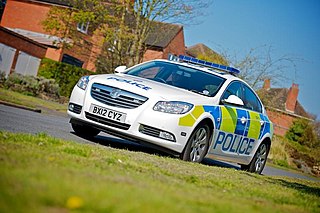
A police car is a ground vehicle used by police for transportation during patrols and to enable them to respond to incidents and chases. Typical uses of a police car include transporting officers so they can reach the scene of an incident quickly, transporting and temporarily detaining suspects in the back seats, as a location to use their police radio or laptop, or to patrol an area, all while providing a visible deterrent to crime. Some police cars are specially adapted for certain locations or for certain operations. Police cars typically have rooftop flashing lights, a siren, and emblems or markings indicating that the vehicle is a police car. Some police cars may have reinforced bumpers and alley lights, for illuminating darkened alleys.

A radar detector is an electronic device used by motorists to detect if their speed is being monitored by police or law enforcement using a radar gun. Most radar detectors are used so the driver can reduce the car's speed before being ticketed for speeding. In general sense, only emitting technologies, like doppler RADAR, or LIDAR can be detected. Visual speed estimating techniques, like ANPR or VASCAR can not be detected in daytime, but technically vulnerable to detection at night, when IR spotlight is used. There are no reports that piezo sensors can be detected. LIDAR devices require an optical-band sensor, although many modern detectors include LIDAR sensors. Most of today's radar detectors detect signals across a variety of wavelength bands: usually X, K, and Ka. In Europe the Ku band is common as well. The past success of radar detectors was based on the fact that radio-wave beam can not be narrow-enough, so the detector usually senses stray and scattered radiation, giving the driver time to slow down. Based on a focused laser-beam, LIDAR technology does not suffer this shortcoming; however it requires precise aiming. Modern police radars incorporate formidable computing power, producing a minimum number of ultra-short pulses, reusing wide beams for multi-target measurement, which renders most detectors useless. But, mobile Internet allows GPS navigation devices to map police radar locations in real-time. These devices are also often called "radar detectors", while not necessary carrying an RF sensor.
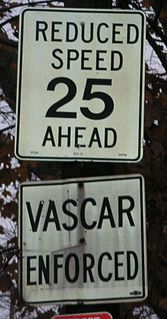
VASCAR is a type of device for calculating the speed of a moving vehicle. The first VASCAR device was created in 1966 by Arthur Marshall. It is used by police officers to enforce speed limits, and may be preferred where radar or lidar is illegal, such as some jurisdictions in Pennsylvania, or to prevent detection by those with radar detectors.
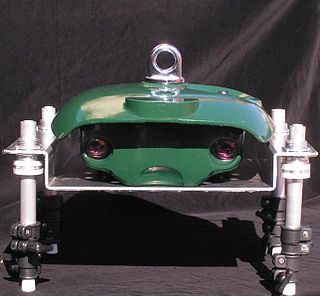
The Infra-Red Traffic Logger, more commonly known simply by the acronym TIRTL, is a multi-purpose traffic sensor that can be used as a traffic counter, speed sensor, red light camera sensor, heavy vehicle tracker, overheight vehicle sensor, rail crossing sensor and network management system. The initial development of the device started in 1997 in conjunction with the New South Wales Roads and Traffic Authority & started commercial domestic and international sales in 2002. It is currently in use in sixteen countries.

Vehicle safety technology (VST) in the automotive industry refers to the special technology developed to ensure the safety and security of automobiles and their passengers. The term encompasses a broad umbrella of projects and devices within the automotive world. Notable examples of VST include geo-fencing capabilities, remote speed sensing, theft deterrence, damage mitigation, vehicle-to-vehicle communication, and car-to-computer communication devices which use GPS tracking.
Driving in the United Kingdom is governed by various legal powers and in some cases is subject to the passing of a driving test. The government produces a Highway Code that details the requirements for all road users, including drivers. Unlike most other countries in the world, UK traffic drives on the left.
Intelligent speed adaptation (ISA), also known as alerting, and intelligent authority, is any system that ensures that vehicle speed does not exceed a safe or legally enforced speed. In case of potential speeding, a human driver can be alerted, or the speed reduced automatically.
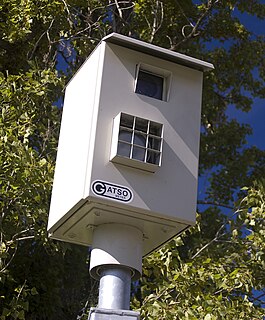
Speed limits are enforced on most public roadways by authorities, with the purpose to improve driver compliance with speed limits. Methods used include roadside speed traps set up and operated by the police and automated roadside 'speed camera' systems, which may incorporate the use of an automatic number plate recognition system. Traditionally, police officers used stopwatches to measure the time taken for a vehicle to cover a known distance. More recently, radar guns and automated in-vehicle systems have come into use.

Road speed limits in the United Kingdom are used to define the maximum legal speed for vehicles using public roads in the UK. Speed limits are one of the measures available to attempt to control traffic speeds, reduce negative environmental effects of traffic, increase fuel use efficiency and satisfy local community wishes. The speed limit in each location is indicated on a nearby traffic sign or by the presence of street lighting. Signs show speed limits in miles per hour (mph) or the national speed limit (NSL) sign may be used.
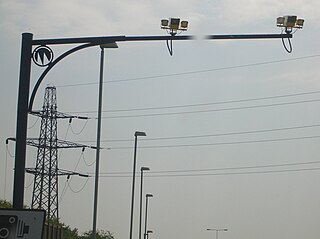
Road speed limit enforcement in the United Kingdom is the action taken by appropriately empowered authorities to attempt to persuade road vehicle users to comply with the speed limits in force on the UK's roads. Methods used include those for detection and prosecution of contraventions such as roadside fixed speed cameras, average speed cameras, and police-operated LIDAR speed guns or older radar speed guns. Vehicle activated signs and Community Speed Watch schemes are used to encourage compliance. Some classes of vehicles are fitted with speed limiters and intelligent speed adaptation is being trialled in some places on a voluntary basis.

Lidar has a wide range of applications; one use is in traffic enforcement and in particular speed limit enforcement, has been gradually replacing radar since 2000. Current devices are designed to automate the entire process of speed detection, vehicle identification, driver identification and evidentiary documentation.






















